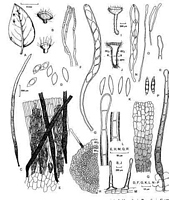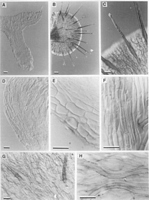|
 Torrendiella grisea Torrendiella grisea
BiostatusAbsent from region
Images (click to enlarge)
Caption: Fig. 7 A-G Torrendiella dingleyae (PDD 57727). A, Nothofagus solandri leaf with apothecia;
B, apothecia; C, seta; D, mature (right) and immature (left | 
Caption: Fig. 9 Torrendiella grisea (A, D-E, BCRU 1766; B-C, F-H, BCRU 3833). A, apothecium in
vertical section; B, apothecium in squash mount showing pale setae; C, detail of setae; |
Article: Johnston, P.R.; Gamundí, I.J. (2000). Torrendiella (Ascomycota, Helotiales) on Nothofagus. New Zealand Journal of Botany 38(3): 493-513 (http://www.rsnz.org/publish/abstracts.php).
Description: Apothecia developing on both sides of fallen leaves; erumpent through host
tissue, arising from small patch of stromatic tissue at base of stipe; apothecia 0.45-1 mm
diam., stipitate, fleshy, fragile; disc plane, pale grey to brownish; receptacle grey to pale
yellowish brown with scattered, pale, stiff setae; stipe 0.4-1 x 0.15-0.25 mm, narrow-cylindric, concolorous with receptacle, darkened near base, the colour coming from the inner
layer. Paraphyses 2-2.5 µm diam., undifferentiated or branched, about same length as asci.
Asci 70-106 x 7.5-12 µm, cylindric-clavate, tapering to truncate apex, wall thickened at apex,
pore with weak amyloid reaction, 8-spored. Ascospores 16.5-20.5 x 4-5 µm, fusoid, flattened
one side, slightly curved, acute to the ends, 2-4 guttulate, hyaline; 1-2-seriate. Ectal
excipulum 3-layered; outer layer very poorly developed, lacking on stipe, on receptacle
comprising meandering, long-cylindric cells 3-4 µm diam. with walls encrusted, hyaline to
pale brown; central layer 30-40 µm wide in receptacle, here comprising broad cylindric cells
15-30 x 6-12 µm with walls slightly thickened, agglutinated, hyaline, in stipe this layer
narrower, comprising long cylindric cells 20-40 x 3-6 µm with walls gelatinised, hyaline;
inner layer poorly developed in receptacle, in stipe comprising long cylindric cells with walls
thinly encrusted, hyaline to pale brown, nongelatinous. Medullary excipulum comprising
textura intricata of hyphae 2-5 µm diam. with walls hyaline, nongelatinous. Setae arising
from outer excipular layer, 100-250 x 6.5-7.5 µm, slightly swollen near the base, tapering to
simple base, tapering gradually toward apex, with upper 2-3 cells swollen to 10-13 µm diam.
at the broadly rounded apex, walls smooth, pale brown, upper 2-3 cells hyaline, pluriseptate;
setae on stipe slightly shorter, 40-120 µm long.
Notes: ETYMOLOGY: The specific epithet refers to the pale grey colour of the receptacle and
hymenium.
T. grisea, known only from Nothofagus dombeyi, is characterised by the pale brown
setae that are swollen and hyaline at the apex. Although unusual for Torrendiella, at least one
other species, an undescribed species from Epacridaceae from Australia and New Zealand,
has the same kind of setae (P.R. Johnston, unpubl. data). The setae of these fungi are very
like those of Zoellneria rosarum, the type of Zoellneria; however that genus differs from
Torrendiella in other respects (see Introduction). The 3-layered nature of the ectal excipulum
is poorly developed in T. grisea.
Note that the collections BAFC 20267a and 20347 were recorded erroneously by
Gamundí (1962) as Zoellneria eucalypti.
|